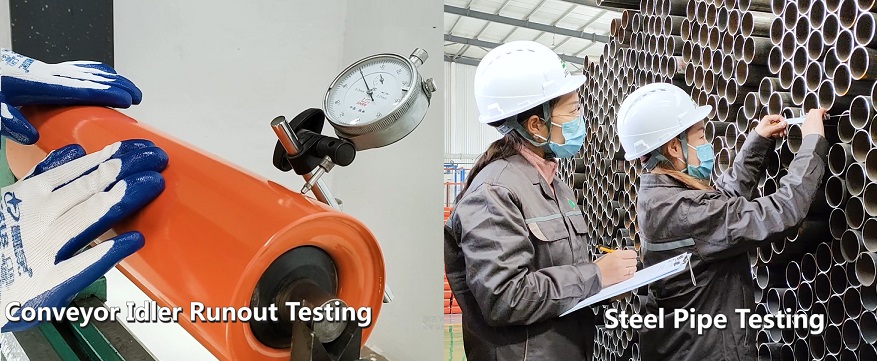The conveyor idler is an important rotating part of the belt conveyor. Although the overall structure of the conveyor idler is relatively simple, there are still many parameters that cannot be ignored, otherwise it will directly affect the conveying efficiency and even the safety of the conveying line. Among them, the radial runout of the roller body (hereinafter referred to as the radial runout of the conveyor idler) is a very important parameter, which has a direct impact on the operating efficiency, service life, and power consumption of the belt conveyor. The radial runout of the conveyor idler is small, then the vibration is small, the conveyor runs smoothly and easily, the service life is long, and the power consumption is small. Therefore, when designing and manufacturing conveyor idlers, manufacturers must strictly control this parameter within the normal range.
So how can radial runout be minimized?
1. Control the outer circle error of the conveyor idler steel pipe

Ensuring that the shape accuracy of the purchased conveyor idler pipes meets the specified requirements is the prerequisite for controlling the radial runout of the conveyor idlers. In terms of pipe shape, it mainly controls the outer diameter tolerance, ellipticity, curvature and other variables of the pipe. The specific requirements are shown in Table 1.
|
Pipe Thickness Tolerance |
Ellipticity |
Curvature |
|
±0.3 |
≤0.4 |
Not more than 0.5 per meter |
2. Control the outer circle error of the bearing house
Like the conveyor steel pipe, the outer circle error of the bearing house is also one of the main reasons for the radial runout. The conveyor idler bearing house is divided into two types, one is a stamping bearing house, and the other is a cast iron bearing house. Most stamping bearing houses are welded with steel pipes, and cast iron bearing houses are all extruded with steel pipes. The stamping bearing house is characterized by good sealing and strong overall bearing capacity. The cast iron bearing house is characterized by high concentricity, but its bearing capacity is lower than that of the punching bearing house.

3. Strengthen and control processing errors
The error in the machining process is also an important cause of the axial runout error, including lathe accuracy, knife edge accuracy and so on. When processing the spigot, its ellipticity is difficult to control, so the inspection of the radial dimension of the spigot adopts the "cross line" measurement and averaging method, and the specified sampling inspection method is used during the processing. At the same time, standard bearing houses can also be used for trial assembly to ensure that there is a specified amount of interference. The concentricity between the spigot at both ends of the pipe and the outer circle is checked by the wall thickness difference method, and the peripheral wall thickness tolerance is 0.3mm.

Most conveyor idler manufacturers have relatively loose control over the radial runout, mainly due to insufficient control over the manufacturing process. It is indeed difficult to meet the standard with conventional process methods, and the pass rate is only 20% to 30%. The JIENASI conveyor idler reduce both ends of the roller steel pipe at the same time through the necking process, which effectively corrects and solves the problems caused by the thermal stress of the steel pipe body and the bearing houses at both ends caused by the welding of the pipe wall and the bearing house. The radial runout problem caused by the out-of-roundness of the steel pipe improves the service performance of the conveyor idler and prolongs its service life.

The reduction process is carried out on the roller body of the idler
The necking process is one of the basic stamping processes in metal cold plastic deformation, which belongs to the compression molding process. A molding method. The necking process has the advantages of saving raw materials, simple mold structure, and improving the mechanical properties of the parts. The necking process is applied to the manufacturing process of the conveyor idler body, and the adverse effects caused by raw materials and processing errors are further corrected.
A Step-by-Step Guide to Selecting the Right Conveyor Idlers 2023
10 basic factors to consider when choosing a suitable conveyor idler
Only one table can help you easily choose the right conveyor idler set (belt width from500~2400mm)
3 key parts that most affect the operating life of conveyor idlers






Contact: Export Department
Phone: +86 15097752737
Tel: +86 0312 5308005
Company: Baoding Zhuoli Machinery Co.,Ltd
Add: 3934 Tower3,Weilaishi building,Xiongan New Area.Baoding city,China